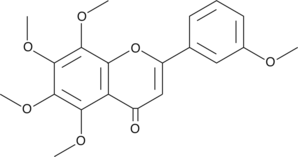Chemicals
Showing 37201–37350 of 41137 results
-
Tandutinib is a potent antagonist of platelet-derived growth factor receptor β (PDGFRβ), FLT3, and c-Kit (IC50 = 200, 220, and 170 nM, respectively).{24623} It less potently inhibits macrophage colony-stimulating factor 1 receptor (IC50 = 3.4 µM) and does not significantly inhibit other tyrosine or serine/threonine kinases.{24623,24622} Tandutinib blocks the growth of cells expressing an internal tandem duplication within the juxtamembrane domain of the FLT3 receptor, found in some acute myelogenous leukemia cells.{24623,24624} It also impairs the growth of colon cancer cells through its actions on the c-Kit receptor.{24621} Tandutinib reverses multidrug resistance in vitro by impairing the efflux activity of the multidrug resistance protein 7.{24625}
Brand:CaymanSKU:12098 - 100 mgAvailable on backorder
Tandutinib is a potent antagonist of platelet-derived growth factor receptor β (PDGFRβ), FLT3, and c-Kit (IC50 = 200, 220, and 170 nM, respectively).{24623} It less potently inhibits macrophage colony-stimulating factor 1 receptor (IC50 = 3.4 µM) and does not significantly inhibit other tyrosine or serine/threonine kinases.{24623,24622} Tandutinib blocks the growth of cells expressing an internal tandem duplication within the juxtamembrane domain of the FLT3 receptor, found in some acute myelogenous leukemia cells.{24623,24624} It also impairs the growth of colon cancer cells through its actions on the c-Kit receptor.{24621} Tandutinib reverses multidrug resistance in vitro by impairing the efflux activity of the multidrug resistance protein 7.{24625}
Brand:CaymanSKU:12098 - 25 mgAvailable on backorder
Tandutinib is a potent antagonist of platelet-derived growth factor receptor β (PDGFRβ), FLT3, and c-Kit (IC50 = 200, 220, and 170 nM, respectively).{24623} It less potently inhibits macrophage colony-stimulating factor 1 receptor (IC50 = 3.4 µM) and does not significantly inhibit other tyrosine or serine/threonine kinases.{24623,24622} Tandutinib blocks the growth of cells expressing an internal tandem duplication within the juxtamembrane domain of the FLT3 receptor, found in some acute myelogenous leukemia cells.{24623,24624} It also impairs the growth of colon cancer cells through its actions on the c-Kit receptor.{24621} Tandutinib reverses multidrug resistance in vitro by impairing the efflux activity of the multidrug resistance protein 7.{24625}
Brand:CaymanSKU:12098 - 250 mgAvailable on backorder
Tandutinib is a potent antagonist of platelet-derived growth factor receptor β (PDGFRβ), FLT3, and c-Kit (IC50 = 200, 220, and 170 nM, respectively).{24623} It less potently inhibits macrophage colony-stimulating factor 1 receptor (IC50 = 3.4 µM) and does not significantly inhibit other tyrosine or serine/threonine kinases.{24623,24622} Tandutinib blocks the growth of cells expressing an internal tandem duplication within the juxtamembrane domain of the FLT3 receptor, found in some acute myelogenous leukemia cells.{24623,24624} It also impairs the growth of colon cancer cells through its actions on the c-Kit receptor.{24621} Tandutinib reverses multidrug resistance in vitro by impairing the efflux activity of the multidrug resistance protein 7.{24625}
Brand:CaymanSKU:12098 - 50 mgAvailable on backorder
Tangeritin is a polymethoxylated flavone isolated from peels of citrus fruits. It inhibits signaling in cancer cells, reducing ERK phosphorylation and growth of estradiol-stimulated T47D breast cancer cells (IC50 ~ 3 μM){16516} and blocking p38 MAPK, JNK, and Akt activation in interleukin-1β-stimulated human lung carcinoma A549 cells.{16517} Tangeritin activates the pregnane X receptor, inducing MDR1 expression in human colonic LS180 cancer cells at a concentration of 10 μM.{16518} It also inhibits growth of tumors and tumor implantation in lungs of mice inoculated with murine melanoma B16F10 cells.{16519} Tangeritin has been shown to protect against tunicamycin-induced cell death in isolated murine insulinoma MIN6 cells and in renal tubular epithelium in mice at a concentration of 10 μM.{16520} More recently, tangeritin has been found to significantly reduce serum total and LDL cholesterol and triacylglycerols in hypercholesteremic hamsters.{16521}
Brand:CaymanSKU:10009911 - 1 mgAvailable on backorder
Tangeritin is a polymethoxylated flavone isolated from peels of citrus fruits. It inhibits signaling in cancer cells, reducing ERK phosphorylation and growth of estradiol-stimulated T47D breast cancer cells (IC50 ~ 3 μM){16516} and blocking p38 MAPK, JNK, and Akt activation in interleukin-1β-stimulated human lung carcinoma A549 cells.{16517} Tangeritin activates the pregnane X receptor, inducing MDR1 expression in human colonic LS180 cancer cells at a concentration of 10 μM.{16518} It also inhibits growth of tumors and tumor implantation in lungs of mice inoculated with murine melanoma B16F10 cells.{16519} Tangeritin has been shown to protect against tunicamycin-induced cell death in isolated murine insulinoma MIN6 cells and in renal tubular epithelium in mice at a concentration of 10 μM.{16520} More recently, tangeritin has been found to significantly reduce serum total and LDL cholesterol and triacylglycerols in hypercholesteremic hamsters.{16521}
Brand:CaymanSKU:10009911 - 100 mgAvailable on backorder
Tangeritin is a polymethoxylated flavone isolated from peels of citrus fruits. It inhibits signaling in cancer cells, reducing ERK phosphorylation and growth of estradiol-stimulated T47D breast cancer cells (IC50 ~ 3 μM){16516} and blocking p38 MAPK, JNK, and Akt activation in interleukin-1β-stimulated human lung carcinoma A549 cells.{16517} Tangeritin activates the pregnane X receptor, inducing MDR1 expression in human colonic LS180 cancer cells at a concentration of 10 μM.{16518} It also inhibits growth of tumors and tumor implantation in lungs of mice inoculated with murine melanoma B16F10 cells.{16519} Tangeritin has been shown to protect against tunicamycin-induced cell death in isolated murine insulinoma MIN6 cells and in renal tubular epithelium in mice at a concentration of 10 μM.{16520} More recently, tangeritin has been found to significantly reduce serum total and LDL cholesterol and triacylglycerols in hypercholesteremic hamsters.{16521}
Brand:CaymanSKU:10009911 - 5 mgAvailable on backorder
Tangeritin is a polymethoxylated flavone isolated from peels of citrus fruits. It inhibits signaling in cancer cells, reducing ERK phosphorylation and growth of estradiol-stimulated T47D breast cancer cells (IC50 ~ 3 μM){16516} and blocking p38 MAPK, JNK, and Akt activation in interleukin-1β-stimulated human lung carcinoma A549 cells.{16517} Tangeritin activates the pregnane X receptor, inducing MDR1 expression in human colonic LS180 cancer cells at a concentration of 10 μM.{16518} It also inhibits growth of tumors and tumor implantation in lungs of mice inoculated with murine melanoma B16F10 cells.{16519} Tangeritin has been shown to protect against tunicamycin-induced cell death in isolated murine insulinoma MIN6 cells and in renal tubular epithelium in mice at a concentration of 10 μM.{16520} More recently, tangeritin has been found to significantly reduce serum total and LDL cholesterol and triacylglycerols in hypercholesteremic hamsters.{16521}
Brand:CaymanSKU:10009911 - 50 mgAvailable on backorder
Tankyrase-IN-2 is an inhibitor of the tankyrases TNKS1 and TNKS2 (IC50s = 7 and 9.2 nM, respectively).{50796} It is selective for TNKS1 and TNKS2 over a panel of 10 additional poly(ADP-ribose) polymerases (PARPs; IC50s = 710->10,000 nM for the human enzymes). Tankyrase-IN-2 increases accumulation of Axin2 and TNKS, indicating inhibition of TNKS-mediated auto-PARsylation, in DLD-1 colorectal cancer cells with EC50 values of 319 and 320 nM, respectively. It also increases tumor Axin2 and TNKS accumulation, as well as decreases tumor levels of active β-catenin, in a DLD-1 mouse xenograft model when administered at doses of 10, 30, and 90 mg/kg.
Brand:CaymanSKU:29808 - 1 mgAvailable on backorder
Tankyrase-IN-2 is an inhibitor of the tankyrases TNKS1 and TNKS2 (IC50s = 7 and 9.2 nM, respectively).{50796} It is selective for TNKS1 and TNKS2 over a panel of 10 additional poly(ADP-ribose) polymerases (PARPs; IC50s = 710->10,000 nM for the human enzymes). Tankyrase-IN-2 increases accumulation of Axin2 and TNKS, indicating inhibition of TNKS-mediated auto-PARsylation, in DLD-1 colorectal cancer cells with EC50 values of 319 and 320 nM, respectively. It also increases tumor Axin2 and TNKS accumulation, as well as decreases tumor levels of active β-catenin, in a DLD-1 mouse xenograft model when administered at doses of 10, 30, and 90 mg/kg.
Brand:CaymanSKU:29808 - 500 µgAvailable on backorder
Tanomastat is an orally available, non-peptidic inhibitor of matrix metalloproteinase-2 (MMP-2), MMP-3, and MMP-9 (Kis = 11, 143, and 301 nM, respectively).{23056} It is active in various animal models of tumor metastasis and has been used in a phase III clinical trial in pancreatic, SCLC, NSCLC, and ovarian cancer patients.{31162,25117}
Brand:CaymanSKU:-Available on backorder
Tanomastat is an orally available, non-peptidic inhibitor of matrix metalloproteinase-2 (MMP-2), MMP-3, and MMP-9 (Kis = 11, 143, and 301 nM, respectively).{23056} It is active in various animal models of tumor metastasis and has been used in a phase III clinical trial in pancreatic, SCLC, NSCLC, and ovarian cancer patients.{31162,25117}
Brand:CaymanSKU:-Available on backorder
Tanomastat is an orally available, non-peptidic inhibitor of matrix metalloproteinase-2 (MMP-2), MMP-3, and MMP-9 (Kis = 11, 143, and 301 nM, respectively).{23056} It is active in various animal models of tumor metastasis and has been used in a phase III clinical trial in pancreatic, SCLC, NSCLC, and ovarian cancer patients.{31162,25117}
Brand:CaymanSKU:-Available on backorder
Tanomastat is an orally available, non-peptidic inhibitor of matrix metalloproteinase-2 (MMP-2), MMP-3, and MMP-9 (Kis = 11, 143, and 301 nM, respectively).{23056} It is active in various animal models of tumor metastasis and has been used in a phase III clinical trial in pancreatic, SCLC, NSCLC, and ovarian cancer patients.{31162,25117}
Brand:CaymanSKU:-Available on backorder
Tanshinone I is a diterpene that has been found in S. miltiorrhiza and has diverse biological activities, including anticancer, antidiabetic, and neuroprotective properties.{43902,43903,43904,43905} It inhibits proliferation in a variety of cancer cell lines, including KB/VCR, MCF-7/ADR, and K562/A02 multidrug resistance cell lines.{43903} It inhibits topoisomerase I- and topoisomerase II-mediated supercoiled DNA relaxation activity when used at concentrations of 200 and 25 µM, respectively. Tanshinone I also inhibits proliferation of H358-IR and H157-IR radioresistant lung cancer cells (IC50s = 10.87 and 6.1 µM, respectively) and sensitizes them to radiation.{43904} It reduces plasma levels of total cholesterol, triglycerides, LDL, and nonesterified fatty acids and decreases blood glucose levels in a rat model of type 2 diabetes induced by streptozotocin (Item No. 13104) and a high-fat diet.{43906} Tanshinone I reduces the LPS-induced expression of TNF-α, IL-1β, and IL-6 in microglia in vitro.{43905} It is neuroprotective in a mouse model of Parkinson’s disease induced by MPTP, preventing dopaminergic cell death in the striatum and improving motor function when administered at a dose of 10 mg/kg per day for two weeks.
Brand:CaymanSKU:26852 - 10 mgAvailable on backorder
Tanshinone I is a diterpene that has been found in S. miltiorrhiza and has diverse biological activities, including anticancer, antidiabetic, and neuroprotective properties.{43902,43903,43904,43905} It inhibits proliferation in a variety of cancer cell lines, including KB/VCR, MCF-7/ADR, and K562/A02 multidrug resistance cell lines.{43903} It inhibits topoisomerase I- and topoisomerase II-mediated supercoiled DNA relaxation activity when used at concentrations of 200 and 25 µM, respectively. Tanshinone I also inhibits proliferation of H358-IR and H157-IR radioresistant lung cancer cells (IC50s = 10.87 and 6.1 µM, respectively) and sensitizes them to radiation.{43904} It reduces plasma levels of total cholesterol, triglycerides, LDL, and nonesterified fatty acids and decreases blood glucose levels in a rat model of type 2 diabetes induced by streptozotocin (Item No. 13104) and a high-fat diet.{43906} Tanshinone I reduces the LPS-induced expression of TNF-α, IL-1β, and IL-6 in microglia in vitro.{43905} It is neuroprotective in a mouse model of Parkinson’s disease induced by MPTP, preventing dopaminergic cell death in the striatum and improving motor function when administered at a dose of 10 mg/kg per day for two weeks.
Brand:CaymanSKU:26852 - 25 mgAvailable on backorder
Tanshinone I is a diterpene that has been found in S. miltiorrhiza and has diverse biological activities, including anticancer, antidiabetic, and neuroprotective properties.{43902,43903,43904,43905} It inhibits proliferation in a variety of cancer cell lines, including KB/VCR, MCF-7/ADR, and K562/A02 multidrug resistance cell lines.{43903} It inhibits topoisomerase I- and topoisomerase II-mediated supercoiled DNA relaxation activity when used at concentrations of 200 and 25 µM, respectively. Tanshinone I also inhibits proliferation of H358-IR and H157-IR radioresistant lung cancer cells (IC50s = 10.87 and 6.1 µM, respectively) and sensitizes them to radiation.{43904} It reduces plasma levels of total cholesterol, triglycerides, LDL, and nonesterified fatty acids and decreases blood glucose levels in a rat model of type 2 diabetes induced by streptozotocin (Item No. 13104) and a high-fat diet.{43906} Tanshinone I reduces the LPS-induced expression of TNF-α, IL-1β, and IL-6 in microglia in vitro.{43905} It is neuroprotective in a mouse model of Parkinson’s disease induced by MPTP, preventing dopaminergic cell death in the striatum and improving motor function when administered at a dose of 10 mg/kg per day for two weeks.
Brand:CaymanSKU:26852 - 5 mgAvailable on backorder
Tanshinone I is a diterpene that has been found in S. miltiorrhiza and has diverse biological activities, including anticancer, antidiabetic, and neuroprotective properties.{43902,43903,43904,43905} It inhibits proliferation in a variety of cancer cell lines, including KB/VCR, MCF-7/ADR, and K562/A02 multidrug resistance cell lines.{43903} It inhibits topoisomerase I- and topoisomerase II-mediated supercoiled DNA relaxation activity when used at concentrations of 200 and 25 µM, respectively. Tanshinone I also inhibits proliferation of H358-IR and H157-IR radioresistant lung cancer cells (IC50s = 10.87 and 6.1 µM, respectively) and sensitizes them to radiation.{43904} It reduces plasma levels of total cholesterol, triglycerides, LDL, and nonesterified fatty acids and decreases blood glucose levels in a rat model of type 2 diabetes induced by streptozotocin (Item No. 13104) and a high-fat diet.{43906} Tanshinone I reduces the LPS-induced expression of TNF-α, IL-1β, and IL-6 in microglia in vitro.{43905} It is neuroprotective in a mouse model of Parkinson’s disease induced by MPTP, preventing dopaminergic cell death in the striatum and improving motor function when administered at a dose of 10 mg/kg per day for two weeks.
Brand:CaymanSKU:26852 - 50 mgAvailable on backorder
Tanshinone IIA (TSA) is a major lipophilic component of extracts from the root of S. miltiorrhiza, used widely in Chinese herbal medicine. It has anti-inflammatory activity, inhibiting production of TNF-α, IL-1β, IL-6, NO, INFγ, and expression of iNOS, and IL-12.{23549,23547} It blocks human aortic smooth muscle cell migration, inhibits MMP-9 activity, and interferes with PI3K/Akt and ERK1/2 signaling pathways.{23548} It is cytotoxic to various cancer cells including A549 lung cancer cells and leukemia cells.{23545,23544}Reduction of TSA by NAD(P)H:quinone oxidoreductase (NQO1) generates an unstable intermediate resulting in reactive oxygenase species-mediated apoptotic cell death.{23546}
Brand:CaymanSKU:-Tanshinone IIA (TSA) is a major lipophilic component of extracts from the root of S. miltiorrhiza, used widely in Chinese herbal medicine. It has anti-inflammatory activity, inhibiting production of TNF-α, IL-1β, IL-6, NO, INFγ, and expression of iNOS, and IL-12.{23549,23547} It blocks human aortic smooth muscle cell migration, inhibits MMP-9 activity, and interferes with PI3K/Akt and ERK1/2 signaling pathways.{23548} It is cytotoxic to various cancer cells including A549 lung cancer cells and leukemia cells.{23545,23544}Reduction of TSA by NAD(P)H:quinone oxidoreductase (NQO1) generates an unstable intermediate resulting in reactive oxygenase species-mediated apoptotic cell death.{23546}
Brand:CaymanSKU:-Tanshinone IIA (TSA) is a major lipophilic component of extracts from the root of S. miltiorrhiza, used widely in Chinese herbal medicine. It has anti-inflammatory activity, inhibiting production of TNF-α, IL-1β, IL-6, NO, INFγ, and expression of iNOS, and IL-12.{23549,23547} It blocks human aortic smooth muscle cell migration, inhibits MMP-9 activity, and interferes with PI3K/Akt and ERK1/2 signaling pathways.{23548} It is cytotoxic to various cancer cells including A549 lung cancer cells and leukemia cells.{23545,23544}Reduction of TSA by NAD(P)H:quinone oxidoreductase (NQO1) generates an unstable intermediate resulting in reactive oxygenase species-mediated apoptotic cell death.{23546}
Brand:CaymanSKU:-Tanshinone IIA (TSA) is a major lipophilic component of extracts from the root of S. miltiorrhiza, used widely in Chinese herbal medicine. It has anti-inflammatory activity, inhibiting production of TNF-α, IL-1β, IL-6, NO, INFγ, and expression of iNOS, and IL-12.{23549,23547} It blocks human aortic smooth muscle cell migration, inhibits MMP-9 activity, and interferes with PI3K/Akt and ERK1/2 signaling pathways.{23548} It is cytotoxic to various cancer cells including A549 lung cancer cells and leukemia cells.{23545,23544}Reduction of TSA by NAD(P)H:quinone oxidoreductase (NQO1) generates an unstable intermediate resulting in reactive oxygenase species-mediated apoptotic cell death.{23546}
Brand:CaymanSKU:-Tanshinone IIA sulfonate is a derivative of tanshinone IIA (Item No. 14323) and has immunomodulatory activities.{52201,52202} It reduces secretion of IL-6 and IL-8 induced by cigarette smoke extract (CSE) and prevents CSE-induced decreases in cystic fibrosis transmembrane conductance regulator (CFTR) levels in 16HBE human bronchial epithelial cells.{52201} Inhalation of tanshinone IIA sulfonate (5 mg/kg) reduces lung function decline, mucus production, bronchial collagen deposition, and airspace enlargement in a mouse model of CS-induced chronic obstructive pulmonary disease (COPD). Tanshinone IIA sulfonate (15 mg/kg) reduces myocardial necrosis and production of TNF-α and IL-6 in a mouse model of sepsis induced by cecal ligation and puncture (CLP).{52202} It reduces the number of peripheral CD4+ and CD8+ T cells and prolongs allogeneic skin graft survival in a rat transplantation model.{52203}
Brand:CaymanSKU:29229 - 1 gAvailable on backorder
Tanshinone IIA sulfonate is a derivative of tanshinone IIA (Item No. 14323) and has immunomodulatory activities.{52201,52202} It reduces secretion of IL-6 and IL-8 induced by cigarette smoke extract (CSE) and prevents CSE-induced decreases in cystic fibrosis transmembrane conductance regulator (CFTR) levels in 16HBE human bronchial epithelial cells.{52201} Inhalation of tanshinone IIA sulfonate (5 mg/kg) reduces lung function decline, mucus production, bronchial collagen deposition, and airspace enlargement in a mouse model of CS-induced chronic obstructive pulmonary disease (COPD). Tanshinone IIA sulfonate (15 mg/kg) reduces myocardial necrosis and production of TNF-α and IL-6 in a mouse model of sepsis induced by cecal ligation and puncture (CLP).{52202} It reduces the number of peripheral CD4+ and CD8+ T cells and prolongs allogeneic skin graft survival in a rat transplantation model.{52203}
Brand:CaymanSKU:29229 - 10 mgAvailable on backorder
Tanshinone IIA sulfonate is a derivative of tanshinone IIA (Item No. 14323) and has immunomodulatory activities.{52201,52202} It reduces secretion of IL-6 and IL-8 induced by cigarette smoke extract (CSE) and prevents CSE-induced decreases in cystic fibrosis transmembrane conductance regulator (CFTR) levels in 16HBE human bronchial epithelial cells.{52201} Inhalation of tanshinone IIA sulfonate (5 mg/kg) reduces lung function decline, mucus production, bronchial collagen deposition, and airspace enlargement in a mouse model of CS-induced chronic obstructive pulmonary disease (COPD). Tanshinone IIA sulfonate (15 mg/kg) reduces myocardial necrosis and production of TNF-α and IL-6 in a mouse model of sepsis induced by cecal ligation and puncture (CLP).{52202} It reduces the number of peripheral CD4+ and CD8+ T cells and prolongs allogeneic skin graft survival in a rat transplantation model.{52203}
Brand:CaymanSKU:29229 - 100 mgAvailable on backorder
Tanshinone IIA sulfonate is a derivative of tanshinone IIA (Item No. 14323) and has immunomodulatory activities.{52201,52202} It reduces secretion of IL-6 and IL-8 induced by cigarette smoke extract (CSE) and prevents CSE-induced decreases in cystic fibrosis transmembrane conductance regulator (CFTR) levels in 16HBE human bronchial epithelial cells.{52201} Inhalation of tanshinone IIA sulfonate (5 mg/kg) reduces lung function decline, mucus production, bronchial collagen deposition, and airspace enlargement in a mouse model of CS-induced chronic obstructive pulmonary disease (COPD). Tanshinone IIA sulfonate (15 mg/kg) reduces myocardial necrosis and production of TNF-α and IL-6 in a mouse model of sepsis induced by cecal ligation and puncture (CLP).{52202} It reduces the number of peripheral CD4+ and CD8+ T cells and prolongs allogeneic skin graft survival in a rat transplantation model.{52203}
Brand:CaymanSKU:29229 - 50 mgAvailable on backorder
TNF-α converting enzyme (TACE, also known as ADAM17) is a zinc metalloprotease that cleaves the membrane-bound precursor of TNF-α to give the mature soluble form of TNF-α.{24091,24093} It also mediates the proteolytic release of several other cell-surface proteins, including TNF-α receptors (TNFRs). TAPI-1, known in the earlier literature as just TAPI, is an inhibitor of TACE that inhibits the cleavage of TNF-α, TNFRI (p60), and TNFRII (p80) with IC50 values ranging from 5-100 µM.{24091,29961,24092} It also blocks the shedding of other TACE-dependent proteins, including IL-6R and Klotho, and may inhibit metalloproteases other than TACE.{24093,15600,29962} TAPI-1 differs from TAPI-0 (Item No. 14694), structurally, by the presence of an aminoethyl addition at the alanyl group, and is generally more stable in tissue culture and in vivo.
Brand:CaymanSKU:-Available on backorder
TNF-α converting enzyme (TACE, also known as ADAM17) is a zinc metalloprotease that cleaves the membrane-bound precursor of TNF-α to give the mature soluble form of TNF-α.{24091,24093} It also mediates the proteolytic release of several other cell-surface proteins, including TNF-α receptors (TNFRs). TAPI-1, known in the earlier literature as just TAPI, is an inhibitor of TACE that inhibits the cleavage of TNF-α, TNFRI (p60), and TNFRII (p80) with IC50 values ranging from 5-100 µM.{24091,29961,24092} It also blocks the shedding of other TACE-dependent proteins, including IL-6R and Klotho, and may inhibit metalloproteases other than TACE.{24093,15600,29962} TAPI-1 differs from TAPI-0 (Item No. 14694), structurally, by the presence of an aminoethyl addition at the alanyl group, and is generally more stable in tissue culture and in vivo.
Brand:CaymanSKU:-Available on backorder
TNF-α converting enzyme (TACE, also known as ADAM17) is a zinc metalloprotease that cleaves the membrane-bound precursor of TNF-α to give the mature soluble form of TNF-α.{24091,24093} It also mediates the proteolytic release of several other cell-surface proteins, including TNF-α receptors (TNFRs). TAPI-1, known in the earlier literature as just TAPI, is an inhibitor of TACE that inhibits the cleavage of TNF-α, TNFRI (p60), and TNFRII (p80) with IC50 values ranging from 5-100 µM.{24091,29961,24092} It also blocks the shedding of other TACE-dependent proteins, including IL-6R and Klotho, and may inhibit metalloproteases other than TACE.{24093,15600,29962} TAPI-1 differs from TAPI-0 (Item No. 14694), structurally, by the presence of an aminoethyl addition at the alanyl group, and is generally more stable in tissue culture and in vivo.
Brand:CaymanSKU:-Available on backorder
The extracellular domains of many different types of transmembrane proteins, including growth factors, growth factor receptors and cell adhesion molecules, are proteolytically released (shed) in response to environmental cues. TNF protease inhibitor 2 (TAPI-2) is a broad-spectrum inhibitor of TNF-α converting enzyme (TACE), other ADAMs (a disintegrin and metalloproteinases), and other matrix metalloproteinases. It inhibits phorbol-12-myristate-13-acetate-induced (PMA) shedding of various cell surface proteins, such as TGF-α, β amyloid precursor protein, L-selectin, and IL-6 receptor α subunit, with an IC50 value of 10 µM.{23493} TAPI-2 inhibits ADAM8, 10, 12, and TACE with Ki values of 10, 3, 100, and 0.12 µM, respectively.{23492} In T4-2 breast cancer cells, 20 µM TAPI-2 prevented mobilization of the growth factors TGF-α and amphiregulin leading to reversion of the malignant cellular phenotype.{23494}
Brand:CaymanSKU:-The extracellular domains of many different types of transmembrane proteins, including growth factors, growth factor receptors and cell adhesion molecules, are proteolytically released (shed) in response to environmental cues. TNF protease inhibitor 2 (TAPI-2) is a broad-spectrum inhibitor of TNF-α converting enzyme (TACE), other ADAMs (a disintegrin and metalloproteinases), and other matrix metalloproteinases. It inhibits phorbol-12-myristate-13-acetate-induced (PMA) shedding of various cell surface proteins, such as TGF-α, β amyloid precursor protein, L-selectin, and IL-6 receptor α subunit, with an IC50 value of 10 µM.{23493} TAPI-2 inhibits ADAM8, 10, 12, and TACE with Ki values of 10, 3, 100, and 0.12 µM, respectively.{23492} In T4-2 breast cancer cells, 20 µM TAPI-2 prevented mobilization of the growth factors TGF-α and amphiregulin leading to reversion of the malignant cellular phenotype.{23494}
Brand:CaymanSKU:-Taprostene is a stable prostacyclin (PGI2) analog and agonist of the prostacyclin receptor, IP. It does not activate the PGE2 receptor EP4,{15488} which, like IP, promotes vascular smooth muscle relaxation when stimulated. Taprostene has been used extensively to study the role of the IP receptor in tissue preparations{15488,17478} and in vivo.{15995,17479} It has also been used in the screening and evaluation of potential IP antagonists.{15914}
Brand:CaymanSKU:10011348 - 1 mgAvailable on backorder
Taprostene is a stable prostacyclin (PGI2) analog and agonist of the prostacyclin receptor, IP. It does not activate the PGE2 receptor EP4,{15488} which, like IP, promotes vascular smooth muscle relaxation when stimulated. Taprostene has been used extensively to study the role of the IP receptor in tissue preparations{15488,17478} and in vivo.{15995,17479} It has also been used in the screening and evaluation of potential IP antagonists.{15914}
Brand:CaymanSKU:10011348 - 5 mgAvailable on backorder
Taprostene is a stable prostacyclin (PGI2) analog and agonist of the prostacyclin receptor, IP. It does not activate the PGE2 receptor EP4,{15488} which, like IP, promotes vascular smooth muscle relaxation when stimulated. Taprostene has been used extensively to study the role of the IP receptor in tissue preparations{15488,17478} and in vivo.{15995,17479} It has also been used in the screening and evaluation of potential IP antagonists.{15914}
Brand:CaymanSKU:10011348 - 500 µgAvailable on backorder
Taranabant is a cannabinoid (CB) receptor 1 inverse agonist (Ki = 0.13 nM).{57169} It is selective for CB1 over CB2 receptors (Ki = 170 nM), as well as a panel of 170 receptors, enzymes, ion channels, and transporters at 1 µM. Taranabant increases forskolin-induced cAMP production in CHO cell membranes expressing human CB1 (EC50 = 2 nM). In vivo, taranabant (3 mg/kg) reverses hypothermia induced by the CB receptor agonist CP 55,940 in rats. Taranabant (1 and 3 mg/kg) reduces two-hour and overnight food intake, as well as overnight weight gain in wild-type, but not CB1 receptor-deficient, mice.
Brand:CaymanSKU:10009795 - 1 mgAvailable on backorder
Taranabant is a cannabinoid (CB) receptor 1 inverse agonist (Ki = 0.13 nM).{57169} It is selective for CB1 over CB2 receptors (Ki = 170 nM), as well as a panel of 170 receptors, enzymes, ion channels, and transporters at 1 µM. Taranabant increases forskolin-induced cAMP production in CHO cell membranes expressing human CB1 (EC50 = 2 nM). In vivo, taranabant (3 mg/kg) reverses hypothermia induced by the CB receptor agonist CP 55,940 in rats. Taranabant (1 and 3 mg/kg) reduces two-hour and overnight food intake, as well as overnight weight gain in wild-type, but not CB1 receptor-deficient, mice.
Brand:CaymanSKU:10009795 - 10 mgAvailable on backorder
Taranabant is a cannabinoid (CB) receptor 1 inverse agonist (Ki = 0.13 nM).{57169} It is selective for CB1 over CB2 receptors (Ki = 170 nM), as well as a panel of 170 receptors, enzymes, ion channels, and transporters at 1 µM. Taranabant increases forskolin-induced cAMP production in CHO cell membranes expressing human CB1 (EC50 = 2 nM). In vivo, taranabant (3 mg/kg) reverses hypothermia induced by the CB receptor agonist CP 55,940 in rats. Taranabant (1 and 3 mg/kg) reduces two-hour and overnight food intake, as well as overnight weight gain in wild-type, but not CB1 receptor-deficient, mice.
Brand:CaymanSKU:10009795 - 5 mgAvailable on backorder
Taranabant is a cannabinoid (CB) receptor 1 inverse agonist (Ki = 0.13 nM).{57169} It is selective for CB1 over CB2 receptors (Ki = 170 nM), as well as a panel of 170 receptors, enzymes, ion channels, and transporters at 1 µM. Taranabant increases forskolin-induced cAMP production in CHO cell membranes expressing human CB1 (EC50 = 2 nM). In vivo, taranabant (3 mg/kg) reverses hypothermia induced by the CB receptor agonist CP 55,940 in rats. Taranabant (1 and 3 mg/kg) reduces two-hour and overnight food intake, as well as overnight weight gain in wild-type, but not CB1 receptor-deficient, mice.
Brand:CaymanSKU:10009795 - 500 µgAvailable on backorder
Tariquidar is an anthranilic acid derivative that binds to P-glycoprotein (Kd = 5.1 nM) and inhibits transport activity.{41596} It inhibits transport of vinblastine (Item No. 11762) and paclitaxel (Item No. 10461) in multidrug resistant CHrB30 cells, increasing the steady state accumulation to non-P-glycoprotein-expressing multidrug sensitive cell levels (EC50 = 487 nM). Tariquidar also enhances the distribution of its substrates, increasing the amount of substrate entering the CNS.{41597} When administered at doses of 2 and 6.25 mg/kg in mice in combination with the peripherally-restricted opioid loperamide, the latency to paw withdrawal in a hot plate assay increases, indicating that loperamide is transported into the CNS.
Brand:CaymanSKU:24180 - 10 mgAvailable on backorder
Tariquidar is an anthranilic acid derivative that binds to P-glycoprotein (Kd = 5.1 nM) and inhibits transport activity.{41596} It inhibits transport of vinblastine (Item No. 11762) and paclitaxel (Item No. 10461) in multidrug resistant CHrB30 cells, increasing the steady state accumulation to non-P-glycoprotein-expressing multidrug sensitive cell levels (EC50 = 487 nM). Tariquidar also enhances the distribution of its substrates, increasing the amount of substrate entering the CNS.{41597} When administered at doses of 2 and 6.25 mg/kg in mice in combination with the peripherally-restricted opioid loperamide, the latency to paw withdrawal in a hot plate assay increases, indicating that loperamide is transported into the CNS.
Brand:CaymanSKU:24180 - 100 mgAvailable on backorder
Tariquidar is an anthranilic acid derivative that binds to P-glycoprotein (Kd = 5.1 nM) and inhibits transport activity.{41596} It inhibits transport of vinblastine (Item No. 11762) and paclitaxel (Item No. 10461) in multidrug resistant CHrB30 cells, increasing the steady state accumulation to non-P-glycoprotein-expressing multidrug sensitive cell levels (EC50 = 487 nM). Tariquidar also enhances the distribution of its substrates, increasing the amount of substrate entering the CNS.{41597} When administered at doses of 2 and 6.25 mg/kg in mice in combination with the peripherally-restricted opioid loperamide, the latency to paw withdrawal in a hot plate assay increases, indicating that loperamide is transported into the CNS.
Brand:CaymanSKU:24180 - 25 mgAvailable on backorder
Tariquidar is an anthranilic acid derivative that binds to P-glycoprotein (Kd = 5.1 nM) and inhibits transport activity.{41596} It inhibits transport of vinblastine (Item No. 11762) and paclitaxel (Item No. 10461) in multidrug resistant CHrB30 cells, increasing the steady state accumulation to non-P-glycoprotein-expressing multidrug sensitive cell levels (EC50 = 487 nM). Tariquidar also enhances the distribution of its substrates, increasing the amount of substrate entering the CNS.{41597} When administered at doses of 2 and 6.25 mg/kg in mice in combination with the peripherally-restricted opioid loperamide, the latency to paw withdrawal in a hot plate assay increases, indicating that loperamide is transported into the CNS.
Brand:CaymanSKU:24180 - 5 mgAvailable on backorder
TAS 103 is an inhibitor of DNA topoisomerase I and II (IC50s = 2 and 6.5 µM, respectively).{57221} It stabilizes topoisomerase I-DNA and topoisomerase II-DNA cleavable complexes in KB cells when used at a concentration of 3 µM. It is cytotoxic to P388 and KB cells (IC50s = 1.1 and 9.6 nM, respectively). TAS 103 (15, 26, and 45 mg/kg per day) reduces pulmonary metastasis in murine B16-BL6 melanoma and UV-2237M fibrosarcoma models of lung metastasis. It also reduces tumor growth in a variety of human cancer mouse xenograft models.
Brand:CaymanSKU:29869 - 10 mgAvailable on backorder
TAS 103 is an inhibitor of DNA topoisomerase I and II (IC50s = 2 and 6.5 µM, respectively).{57221} It stabilizes topoisomerase I-DNA and topoisomerase II-DNA cleavable complexes in KB cells when used at a concentration of 3 µM. It is cytotoxic to P388 and KB cells (IC50s = 1.1 and 9.6 nM, respectively). TAS 103 (15, 26, and 45 mg/kg per day) reduces pulmonary metastasis in murine B16-BL6 melanoma and UV-2237M fibrosarcoma models of lung metastasis. It also reduces tumor growth in a variety of human cancer mouse xenograft models.
Brand:CaymanSKU:29869 - 100 mgAvailable on backorder
TAS 103 is an inhibitor of DNA topoisomerase I and II (IC50s = 2 and 6.5 µM, respectively).{57221} It stabilizes topoisomerase I-DNA and topoisomerase II-DNA cleavable complexes in KB cells when used at a concentration of 3 µM. It is cytotoxic to P388 and KB cells (IC50s = 1.1 and 9.6 nM, respectively). TAS 103 (15, 26, and 45 mg/kg per day) reduces pulmonary metastasis in murine B16-BL6 melanoma and UV-2237M fibrosarcoma models of lung metastasis. It also reduces tumor growth in a variety of human cancer mouse xenograft models.
Brand:CaymanSKU:29869 - 25 mgAvailable on backorder
TAS 103 is an inhibitor of DNA topoisomerase I and II (IC50s = 2 and 6.5 µM, respectively).{57221} It stabilizes topoisomerase I-DNA and topoisomerase II-DNA cleavable complexes in KB cells when used at a concentration of 3 µM. It is cytotoxic to P388 and KB cells (IC50s = 1.1 and 9.6 nM, respectively). TAS 103 (15, 26, and 45 mg/kg per day) reduces pulmonary metastasis in murine B16-BL6 melanoma and UV-2237M fibrosarcoma models of lung metastasis. It also reduces tumor growth in a variety of human cancer mouse xenograft models.
Brand:CaymanSKU:29869 - 50 mgAvailable on backorder
TAS 120 is an orally bioavailable inhibitor of fibroblast growth factor receptors (FGFRs) that irreversibly inhibits all four FGFR subtypes at nanomolar concentrations.{34144} It prevents phosphorylation of FGFRs and impedes downstream signaling pathways in cells.{34144} TAS 120 blocks the proliferation of human cancer cell lines with FGFR gene abnormalities but does not alter the growth of cell lines with wild-type FGFR.{34144} It inhibits FGFR phosphorylation in tumors and tumor growth in human xenograft mouse models in a dose-dependent manner.{34144}
Brand:CaymanSKU:21136 -Out of stock
TAS 120 is an orally bioavailable inhibitor of fibroblast growth factor receptors (FGFRs) that irreversibly inhibits all four FGFR subtypes at nanomolar concentrations.{34144} It prevents phosphorylation of FGFRs and impedes downstream signaling pathways in cells.{34144} TAS 120 blocks the proliferation of human cancer cell lines with FGFR gene abnormalities but does not alter the growth of cell lines with wild-type FGFR.{34144} It inhibits FGFR phosphorylation in tumors and tumor growth in human xenograft mouse models in a dose-dependent manner.{34144}
Brand:CaymanSKU:21136 -Out of stock
TAS 120 is an orally bioavailable inhibitor of fibroblast growth factor receptors (FGFRs) that irreversibly inhibits all four FGFR subtypes at nanomolar concentrations.{34144} It prevents phosphorylation of FGFRs and impedes downstream signaling pathways in cells.{34144} TAS 120 blocks the proliferation of human cancer cell lines with FGFR gene abnormalities but does not alter the growth of cell lines with wild-type FGFR.{34144} It inhibits FGFR phosphorylation in tumors and tumor growth in human xenograft mouse models in a dose-dependent manner.{34144}
Brand:CaymanSKU:21136 -Out of stock
TAS 120 is an orally bioavailable inhibitor of fibroblast growth factor receptors (FGFRs) that irreversibly inhibits all four FGFR subtypes at nanomolar concentrations.{34144} It prevents phosphorylation of FGFRs and impedes downstream signaling pathways in cells.{34144} TAS 120 blocks the proliferation of human cancer cell lines with FGFR gene abnormalities but does not alter the growth of cell lines with wild-type FGFR.{34144} It inhibits FGFR phosphorylation in tumors and tumor growth in human xenograft mouse models in a dose-dependent manner.{34144}
Brand:CaymanSKU:21136 -Out of stock
TAS 301 (10 μM) impedes Ca2+ mobilization and Ca2+/calmodulin-dependent protein kinase II (CaM kinase II) activation that inhibits vascular smooth muscle cell (VSMC) proliferation in vitro.{34683,34682} At a concentration of 10 μM, TAS 301 also inhibits platelet-derived growth factor (PDGF)-induced tyrosine phosphorylation of focal adhesion kinase and paxillin and promotes cytoskeletal rearrangment.{34683} TAS 301 (3-100 mg/kg) inhibits migration and proliferation of VSMCs and prevents arterial intimal thickening in vivo in a model of balloon-injured arteries in rats.{34680} In a micro pig model, TAS 301 administration (30-100 mg/kg) prevents coronary artery stenosis after balloon overstretch injury.{34681}
Brand:CaymanSKU:-TAS 301 (10 μM) impedes Ca2+ mobilization and Ca2+/calmodulin-dependent protein kinase II (CaM kinase II) activation that inhibits vascular smooth muscle cell (VSMC) proliferation in vitro.{34683,34682} At a concentration of 10 μM, TAS 301 also inhibits platelet-derived growth factor (PDGF)-induced tyrosine phosphorylation of focal adhesion kinase and paxillin and promotes cytoskeletal rearrangment.{34683} TAS 301 (3-100 mg/kg) inhibits migration and proliferation of VSMCs and prevents arterial intimal thickening in vivo in a model of balloon-injured arteries in rats.{34680} In a micro pig model, TAS 301 administration (30-100 mg/kg) prevents coronary artery stenosis after balloon overstretch injury.{34681}
Brand:CaymanSKU:-TAS 301 (10 μM) impedes Ca2+ mobilization and Ca2+/calmodulin-dependent protein kinase II (CaM kinase II) activation that inhibits vascular smooth muscle cell (VSMC) proliferation in vitro.{34683,34682} At a concentration of 10 μM, TAS 301 also inhibits platelet-derived growth factor (PDGF)-induced tyrosine phosphorylation of focal adhesion kinase and paxillin and promotes cytoskeletal rearrangment.{34683} TAS 301 (3-100 mg/kg) inhibits migration and proliferation of VSMCs and prevents arterial intimal thickening in vivo in a model of balloon-injured arteries in rats.{34680} In a micro pig model, TAS 301 administration (30-100 mg/kg) prevents coronary artery stenosis after balloon overstretch injury.{34681}
Brand:CaymanSKU:-Tasimelteon is a melatonin (MT) receptor agonist (Kis = 0.304 and 0.069 nM for MT1 and MT2, respectively, in NIH3T3 cells).{38574} It is selective for MT receptors over 160 other receptors and enzymes. Tasimelteon increases cAMP accumulation induced by forskolin (Item No. 11018) with EC50 values of 0.79 and 1 nM for NIH3T3 cells expressing MT1 and MT2, respectively. Formulations containing tasimelteon have been used in the treatment of non-24-hour sleep-wake disorder.
Brand:CaymanSKU:23546 - 1 mgAvailable on backorder
Tasimelteon is a melatonin (MT) receptor agonist (Kis = 0.304 and 0.069 nM for MT1 and MT2, respectively, in NIH3T3 cells).{38574} It is selective for MT receptors over 160 other receptors and enzymes. Tasimelteon increases cAMP accumulation induced by forskolin (Item No. 11018) with EC50 values of 0.79 and 1 nM for NIH3T3 cells expressing MT1 and MT2, respectively. Formulations containing tasimelteon have been used in the treatment of non-24-hour sleep-wake disorder.
Brand:CaymanSKU:23546 - 10 mgAvailable on backorder
Tasimelteon is a melatonin (MT) receptor agonist (Kis = 0.304 and 0.069 nM for MT1 and MT2, respectively, in NIH3T3 cells).{38574} It is selective for MT receptors over 160 other receptors and enzymes. Tasimelteon increases cAMP accumulation induced by forskolin (Item No. 11018) with EC50 values of 0.79 and 1 nM for NIH3T3 cells expressing MT1 and MT2, respectively. Formulations containing tasimelteon have been used in the treatment of non-24-hour sleep-wake disorder.
Brand:CaymanSKU:23546 - 5 mgAvailable on backorder
TASIN-1 is a small molecule inhibitor that specifically kills cells with adenomatous polyposis coli (APC) truncations (IC50 = 70 nM) but spares cells with wild-type APC.{33039} TASIN-1 is effective in vivo, inhibiting tumor growth of colorectal cancer (CRC) cells with truncated APC, but not wild-type CRC cells, in a mouse xenograft model.{33039} TASIN-1 decreases cholesterol biosynthesis in APC-truncated cells but not in wild-type APC cells.{33039}
Brand:CaymanSKU:21155 -Out of stock
TASIN-1 is a small molecule inhibitor that specifically kills cells with adenomatous polyposis coli (APC) truncations (IC50 = 70 nM) but spares cells with wild-type APC.{33039} TASIN-1 is effective in vivo, inhibiting tumor growth of colorectal cancer (CRC) cells with truncated APC, but not wild-type CRC cells, in a mouse xenograft model.{33039} TASIN-1 decreases cholesterol biosynthesis in APC-truncated cells but not in wild-type APC cells.{33039}
Brand:CaymanSKU:21155 -Out of stock
Tasisulam is an anticancer agent that inhibits the growth of Calu-6 non-small cell lung carcinoma (NSCLC) and A-375 melanoma cell lines (EC50s = 10 and 25 μM, respectively).{39589} It arrests the cell cycle at the G2/M phase and induces apoptosis of Calu-6 cells in a concentration-dependent manner. Tasisulam induces non-apoptotic growth arrest in human vascular endothelial cells (HUVECs) and inhibits VEGF-, FGF-, and EGF-induced endothelial cord formation in vitro (EC50s = 47, 103, and 34 nM, respectively). In vivo, tasisulam (25 and 50 mg/kg) reduces hemoglobin content and blood vessel density in a Matrigel™ plug model of neoangiogenesis. It also reduces tumor growth in a dose-dependent manner in a Calu-6 mouse xenograft model via arrest of the cell cycle at the G2/M phase, induction of apoptosis, and reduction of tumor blood vessel density. Formulations containing tasisulam are under clinical investigation for the treatment of advanced solid tumors.
Brand:CaymanSKU:21556 -Out of stock
Tasisulam is an anticancer agent that inhibits the growth of Calu-6 non-small cell lung carcinoma (NSCLC) and A-375 melanoma cell lines (EC50s = 10 and 25 μM, respectively).{39589} It arrests the cell cycle at the G2/M phase and induces apoptosis of Calu-6 cells in a concentration-dependent manner. Tasisulam induces non-apoptotic growth arrest in human vascular endothelial cells (HUVECs) and inhibits VEGF-, FGF-, and EGF-induced endothelial cord formation in vitro (EC50s = 47, 103, and 34 nM, respectively). In vivo, tasisulam (25 and 50 mg/kg) reduces hemoglobin content and blood vessel density in a Matrigel™ plug model of neoangiogenesis. It also reduces tumor growth in a dose-dependent manner in a Calu-6 mouse xenograft model via arrest of the cell cycle at the G2/M phase, induction of apoptosis, and reduction of tumor blood vessel density. Formulations containing tasisulam are under clinical investigation for the treatment of advanced solid tumors.
Brand:CaymanSKU:21556 -Out of stock
Tasisulam is an anticancer agent that inhibits the growth of Calu-6 non-small cell lung carcinoma (NSCLC) and A-375 melanoma cell lines (EC50s = 10 and 25 μM, respectively).{39589} It arrests the cell cycle at the G2/M phase and induces apoptosis of Calu-6 cells in a concentration-dependent manner. Tasisulam induces non-apoptotic growth arrest in human vascular endothelial cells (HUVECs) and inhibits VEGF-, FGF-, and EGF-induced endothelial cord formation in vitro (EC50s = 47, 103, and 34 nM, respectively). In vivo, tasisulam (25 and 50 mg/kg) reduces hemoglobin content and blood vessel density in a Matrigel™ plug model of neoangiogenesis. It also reduces tumor growth in a dose-dependent manner in a Calu-6 mouse xenograft model via arrest of the cell cycle at the G2/M phase, induction of apoptosis, and reduction of tumor blood vessel density. Formulations containing tasisulam are under clinical investigation for the treatment of advanced solid tumors.
Brand:CaymanSKU:21556 -Out of stock
Tasisulam is an anticancer agent that inhibits the growth of Calu-6 non-small cell lung carcinoma (NSCLC) and A-375 melanoma cell lines (EC50s = 10 and 25 μM, respectively).{39589} It arrests the cell cycle at the G2/M phase and induces apoptosis of Calu-6 cells in a concentration-dependent manner. Tasisulam induces non-apoptotic growth arrest in human vascular endothelial cells (HUVECs) and inhibits VEGF-, FGF-, and EGF-induced endothelial cord formation in vitro (EC50s = 47, 103, and 34 nM, respectively). In vivo, tasisulam (25 and 50 mg/kg) reduces hemoglobin content and blood vessel density in a Matrigel™ plug model of neoangiogenesis. It also reduces tumor growth in a dose-dependent manner in a Calu-6 mouse xenograft model via arrest of the cell cycle at the G2/M phase, induction of apoptosis, and reduction of tumor blood vessel density. Formulations containing tasisulam are under clinical investigation for the treatment of advanced solid tumors.
Brand:CaymanSKU:21556 -Out of stock
Tasosartan is an angiotensin II type 2 (AT2) receptor antagonist (IC50 = 1.2 nM in rat adrenal gland membranes).{48831} It also binds to the AT1 receptor (Ki = 46.6 nM in rat liver epithelial cells).{48832} Tasosartan (3 mg/kg, intraduodenally) reduces the AT2-induced pressor response in rats.{48833} It also decreases mean arterial pressure in a rat model of hypertension induced by renal artery constriction when administered intragastrically or intravenously at doses of 1 and 3 mg/kg.{48831}
Brand:CaymanSKU:29495 - 100 mgAvailable on backorder
Tasosartan is an angiotensin II type 2 (AT2) receptor antagonist (IC50 = 1.2 nM in rat adrenal gland membranes).{48831} It also binds to the AT1 receptor (Ki = 46.6 nM in rat liver epithelial cells).{48832} Tasosartan (3 mg/kg, intraduodenally) reduces the AT2-induced pressor response in rats.{48833} It also decreases mean arterial pressure in a rat model of hypertension induced by renal artery constriction when administered intragastrically or intravenously at doses of 1 and 3 mg/kg.{48831}
Brand:CaymanSKU:29495 - 25 mgAvailable on backorder
Tasosartan is an angiotensin II type 2 (AT2) receptor antagonist (IC50 = 1.2 nM in rat adrenal gland membranes).{48831} It also binds to the AT1 receptor (Ki = 46.6 nM in rat liver epithelial cells).{48832} Tasosartan (3 mg/kg, intraduodenally) reduces the AT2-induced pressor response in rats.{48833} It also decreases mean arterial pressure in a rat model of hypertension induced by renal artery constriction when administered intragastrically or intravenously at doses of 1 and 3 mg/kg.{48831}
Brand:CaymanSKU:29495 - 250 mgAvailable on backorder
Tasosartan is an angiotensin II type 2 (AT2) receptor antagonist (IC50 = 1.2 nM in rat adrenal gland membranes).{48831} It also binds to the AT1 receptor (Ki = 46.6 nM in rat liver epithelial cells).{48832} Tasosartan (3 mg/kg, intraduodenally) reduces the AT2-induced pressor response in rats.{48833} It also decreases mean arterial pressure in a rat model of hypertension induced by renal artery constriction when administered intragastrically or intravenously at doses of 1 and 3 mg/kg.{48831}
Brand:CaymanSKU:29495 - 50 mgAvailable on backorder
Tasquinimod is an orally-active quinoline-3-carboxamide derived from roquinimex, an immunomodulatory quinolone with applications in some cancers and autoimmune diseases.{30963} Tasquinimod inhibits tumor angiogenesis and supplements radiation or chemotherapy in animal models of prostate cancer.{30963,30964} While its precise mechanism of action remains unclear, tasquinimod has been reported to alter signaling through S100A9, thrombospondin-1, HIF-1α, androgen receptor, VEGF, and HDAC3/4.{30963,30964}
Brand:CaymanSKU:-Available on backorder
Tasquinimod is an orally-active quinoline-3-carboxamide derived from roquinimex, an immunomodulatory quinolone with applications in some cancers and autoimmune diseases.{30963} Tasquinimod inhibits tumor angiogenesis and supplements radiation or chemotherapy in animal models of prostate cancer.{30963,30964} While its precise mechanism of action remains unclear, tasquinimod has been reported to alter signaling through S100A9, thrombospondin-1, HIF-1α, androgen receptor, VEGF, and HDAC3/4.{30963,30964}
Brand:CaymanSKU:-Available on backorder
Tasquinimod is an orally-active quinoline-3-carboxamide derived from roquinimex, an immunomodulatory quinolone with applications in some cancers and autoimmune diseases.{30963} Tasquinimod inhibits tumor angiogenesis and supplements radiation or chemotherapy in animal models of prostate cancer.{30963,30964} While its precise mechanism of action remains unclear, tasquinimod has been reported to alter signaling through S100A9, thrombospondin-1, HIF-1α, androgen receptor, VEGF, and HDAC3/4.{30963,30964}
Brand:CaymanSKU:-Available on backorder
Tasquinimod is an orally-active quinoline-3-carboxamide derived from roquinimex, an immunomodulatory quinolone with applications in some cancers and autoimmune diseases.{30963} Tasquinimod inhibits tumor angiogenesis and supplements radiation or chemotherapy in animal models of prostate cancer.{30963,30964} While its precise mechanism of action remains unclear, tasquinimod has been reported to alter signaling through S100A9, thrombospondin-1, HIF-1α, androgen receptor, VEGF, and HDAC3/4.{30963,30964}
Brand:CaymanSKU:-Available on backorder
Taurine is a sulfur-containing amino acid produced endogenously and also ingested in the diet.{43869} It is ubiquitously present in most cells and has diverse biological activities, including antioxidative, anticancer, cardioprotective, and neuroprotective properties.{43869,43870,43871,14507} It scavenges 2,2-diphenyl-1-picrylhydrazyl (DPPH; Item No. 14805) radicals when used at concentrations ranging from 125 to 1,000 µg/ml and decreases the viability of MCF-7 and MDA-MB-231 human breast cancer cells.{43870} It prevents left ventricular function dysfunction in the mdx mouse model of late-stage Duchenne muscular dystrophy when administered at a dose of 1 g/kg per day for six months.{43871} Taurine (100 µM) prevents neurotoxicity induced by amyloid-β (Aβ) or the glutamate receptor agonists glutamate, NMDA (Item No. 14581), or kainic acid (Item No. 78050) in chick embryonic retinal neurons, an effect that can be blocked by the GABAA receptor antagonist picrotoxin (Item No. 20771).{14507}
Brand:CaymanSKU:27031 - 100 gAvailable on backorder
Taurine is a sulfur-containing amino acid produced endogenously and also ingested in the diet.{43869} It is ubiquitously present in most cells and has diverse biological activities, including antioxidative, anticancer, cardioprotective, and neuroprotective properties.{43869,43870,43871,14507} It scavenges 2,2-diphenyl-1-picrylhydrazyl (DPPH; Item No. 14805) radicals when used at concentrations ranging from 125 to 1,000 µg/ml and decreases the viability of MCF-7 and MDA-MB-231 human breast cancer cells.{43870} It prevents left ventricular function dysfunction in the mdx mouse model of late-stage Duchenne muscular dystrophy when administered at a dose of 1 g/kg per day for six months.{43871} Taurine (100 µM) prevents neurotoxicity induced by amyloid-β (Aβ) or the glutamate receptor agonists glutamate, NMDA (Item No. 14581), or kainic acid (Item No. 78050) in chick embryonic retinal neurons, an effect that can be blocked by the GABAA receptor antagonist picrotoxin (Item No. 20771).{14507}
Brand:CaymanSKU:27031 - 250 gAvailable on backorder
Taurine is a sulfur-containing amino acid produced endogenously and also ingested in the diet.{43869} It is ubiquitously present in most cells and has diverse biological activities, including antioxidative, anticancer, cardioprotective, and neuroprotective properties.{43869,43870,43871,14507} It scavenges 2,2-diphenyl-1-picrylhydrazyl (DPPH; Item No. 14805) radicals when used at concentrations ranging from 125 to 1,000 µg/ml and decreases the viability of MCF-7 and MDA-MB-231 human breast cancer cells.{43870} It prevents left ventricular function dysfunction in the mdx mouse model of late-stage Duchenne muscular dystrophy when administered at a dose of 1 g/kg per day for six months.{43871} Taurine (100 µM) prevents neurotoxicity induced by amyloid-β (Aβ) or the glutamate receptor agonists glutamate, NMDA (Item No. 14581), or kainic acid (Item No. 78050) in chick embryonic retinal neurons, an effect that can be blocked by the GABAA receptor antagonist picrotoxin (Item No. 20771).{14507}
Brand:CaymanSKU:27031 - 500 gAvailable on backorder
Tauro-obeticholic acid is an active metabolite of obeticholic acid, which is a farnesoid X receptor (FXR) agonist and semisynthetic derivative of chenodeoxycholic acid (Item No. 10011286).{46303} Tauro-obeticholic acid is formed from obeticholic acid by taurine conjugation in the liver but can be reconverted back to obeticholic acid by intestinal microflora.
Brand:CaymanSKU:28243 - 1 mgAvailable on backorder
Tauro-obeticholic acid is an active metabolite of obeticholic acid, which is a farnesoid X receptor (FXR) agonist and semisynthetic derivative of chenodeoxycholic acid (Item No. 10011286).{46303} Tauro-obeticholic acid is formed from obeticholic acid by taurine conjugation in the liver but can be reconverted back to obeticholic acid by intestinal microflora.
Brand:CaymanSKU:28243 - 5 mgAvailable on backorder
Tauro-α-muricholic acid (TαMCA) is an antagonist of the farnesoid X receptor (FXR; IC50 = 28 µM) and a taurine-conjugated form of the murine-specific primary bile acid α-muricholic acid (Item No. 20291).{33771} TαMCA is common in rodents but has also been found in small amounts in human serum.{41115}
Brand:CaymanSKU:20288 -Available on backorder
Tauro-β-muricholic acid (TβMCA) is a competitive and reversible antagonist of the farnesoid X receptor (FXR; IC50 = 40 µM) and a taurine-conjugated form of the murine-specific primary bile acid β-muricholic acid (Item No. 20287).{33771} TβMCA accumulates in germ-free mice under normal conditions but is reduced after colonization with feces from a human donor.{33771,33772} TβMCA is increased in the intestines of mice resistant to high-fat diet-induced obesity, fatty liver, and diabetes.{33770}
Brand:CaymanSKU:20289 -Available on backorder
Tauro-β-muricholic acid (TβMCA) is a competitive and reversible antagonist of the farnesoid X receptor (FXR; IC50 = 40 µM) and a taurine-conjugated form of the murine-specific primary bile acid β-muricholic acid (Item No. 20287).{33771} TβMCA accumulates in germ-free mice under normal conditions but is reduced after colonization with feces from a human donor.{33771,33772} TβMCA is increased in the intestines of mice resistant to high-fat diet-induced obesity, fatty liver, and diabetes.{33770}
Brand:CaymanSKU:20289 -Available on backorder
Tauro-β-muricholic acid (TβMCA) is a competitive and reversible antagonist of the farnesoid X receptor (FXR; IC50 = 40 µM) and a taurine-conjugated form of the murine-specific primary bile acid β-muricholic acid (Item No. 20287).{33771} TβMCA accumulates in germ-free mice under normal conditions but is reduced after colonization with feces from a human donor.{33771,33772} TβMCA is increased in the intestines of mice resistant to high-fat diet-induced obesity, fatty liver, and diabetes.{33770}
Brand:CaymanSKU:20289 -Available on backorder
Taurochenodeoxycholic acid (TCDCA) is a taurine-conjugated form of the primary bile acid chenodeoxycholic acid (CDCA; Item No. 10011286).{33901} Serum levels of TCDCA increase approximately 5-fold in within two hours and begin to decrease within four hours during an oral lipid tolerance test in humans.{33902} Serum levels of TCDCA are increased in patients with liver cirrhosis and may serve as a marker of disease progression.{33903}
Brand:CaymanSKU:20275 -Available on backorder
Taurochenodeoxycholic acid (TCDCA) is a taurine-conjugated form of the primary bile acid chenodeoxycholic acid (CDCA; Item No. 10011286).{33901} Serum levels of TCDCA increase approximately 5-fold in within two hours and begin to decrease within four hours during an oral lipid tolerance test in humans.{33902} Serum levels of TCDCA are increased in patients with liver cirrhosis and may serve as a marker of disease progression.{33903}
Brand:CaymanSKU:20275 -Available on backorder
























